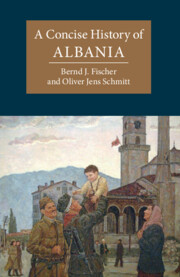Book contents
- A Concise History of Albania
- Cambridge Concise Histories
- A Concise History of Albania
- Copyright page
- Contents
- Illustrations
- Maps
- Preface
- Part I Between Regional Self-Will and Imperial Rule
- Part II State and Nation Construction
- 5 Arnavutluk to Albania: The Triumph of Albanianism, 1912–1924
- 6 Interwar Albania: The Rise of Authoritarianism, 1925–1939
- 7 The Second World War and the Establishment of the Communist Regime, 1939–1944
- 8 Albania’s Stalinist Dictatorship, 1944–1989
- 9 The Struggle to Establish a Democracy since 1989
- Political Systems and the Principal Political Leadership since Independence in 1912
- Suggestions for Further Reading (literature in non-Balkan languages)
- Index
5 - Arnavutluk to Albania: The Triumph of Albanianism, 1912–1924
from Part II - State and Nation Construction
Published online by Cambridge University Press: 18 October 2022
- A Concise History of Albania
- Cambridge Concise Histories
- A Concise History of Albania
- Copyright page
- Contents
- Illustrations
- Maps
- Preface
- Part I Between Regional Self-Will and Imperial Rule
- Part II State and Nation Construction
- 5 Arnavutluk to Albania: The Triumph of Albanianism, 1912–1924
- 6 Interwar Albania: The Rise of Authoritarianism, 1925–1939
- 7 The Second World War and the Establishment of the Communist Regime, 1939–1944
- 8 Albania’s Stalinist Dictatorship, 1944–1989
- 9 The Struggle to Establish a Democracy since 1989
- Political Systems and the Principal Political Leadership since Independence in 1912
- Suggestions for Further Reading (literature in non-Balkan languages)
- Index
Summary
Chapter 5 describes the transformation of a section of Arnavutluk into the modern Albanian state. The new independent Albania was proclaimed by the predominantly Sunni elite when Ottoman rule collapsed in the First Balkan War in 1912 and Albanian settlement areas seemed on the verge of being divided between Serbia, Montenegro and Greece. With the onset of the First World War, the fledgling state was faced with foreign occupation, and threats to its territorial integrity and to its very existence. The chapter examines how in the immediate aftermath of the war, Albanian leaders, meeting at the Congress of Lushnjë, struggled to create a functioning state apparatus but were quickly faced with political conflict which led to coups, assassinations and general instability. In this chaos, power was dominated by those with independent access to armed forces, resulting in the rise of the tribal leader Ahmet Zogu. Fearing his increasing authoritarianism, opposing forced mounted a revolution which ousted Zogu and allowed the construction of a short-lived generally progressive regime. Within six months, however, a counter-revolution brought Zogu back to power.
Keywords
- Type
- Chapter
- Information
- A Concise History of Albania , pp. 145 - 190Publisher: Cambridge University PressPrint publication year: 2022

